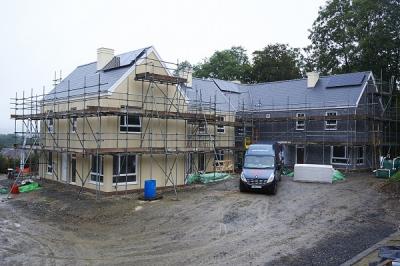Hong Kong’s heritage of bamboo scaffolding
 If you get the chance to go to Hong Kong, make sure you look closely at the many construction sites all over the city.
If you get the chance to go to Hong Kong, make sure you look closely at the many construction sites all over the city.
You may come across bamboo scaffolding like that shown in the photo to the right and above. This scaffolding covered a 25-storey building with what appeared to be thousands of 6m long bamboo poles tied together with either nylon or bamboo straps.
It certainly caused the writer to wonder what health and safety controls might be in place in this remarkable ultra-modern city.
Bamboo has been used for centuries; the profession is believed to date back around 1,500 years and has many advantages compared to metal scaffolding. It’s lightweight, cheap, strong, eco-friendly (completely recyclable), and it can be constructed quickly in any shape to follow the architectural features of a building. Surprisingly, it’s also been shown to be more resistant to cyclones than metal scaffolding!
|
Also read: |
 |
Hong Kong scaffolding licensing
Hong Kong has a similar Construction Industry Council licence system (similar to our CSCS card scheme) for the ‘Taap Pang’ bamboo scaffolders and installation is based on two documents, the Code Of Practice For Bamboo Scaffolding Safety, prepared by the Occupational Safety and Health Branch Labour Department. And Guidelines on the Design and Construction of Bamboo Scaffolds issued by the Building Department.
The latter document offers some sobering guidance on scaffold inspection requirements by a ‘competent person’ over and above what we might normally do in the UK:
5.3 More frequent inspections must be provided when:
a. A tropical cyclone warning signal is announced.
b. A strong monsoon signal is announced.
c. There are severe gusts, especially during April and May.
Hong Kong competent person definition
The guide also defines a competent person as someone who:
a. Has satisfactorily completed formal training in bamboo scaffolding works, such as the 3-year Bamboo Scaffolder Apprenticeship Scheme operated by the Vocational Training Council.
b. Possesses experience of 10 years or more in bamboo scaffolding works (inclusive of experience under the formal period).
c. Should also be able to read and understand the scaffolding plan, design drawings, specifications, and method statement of the scaffolding works, and be capable of identifying existing and potential hazards in the works and surrounding areas.
As such, there is reassurance in the design, installation, and competency control measures in place.
Despite a poor safety record, this versatile material appears likely to be around (side by side with conventional metal scaffolding) for years to come.
Further information
Guidelines on the Design and Construction and Construction of Bamboo Scaffolds
Sign up to the building bulletin newsletter
Over 48,000 construction professionals have already signed up for the LABC Building Bulletin.
Join them and receive useful tips, practical technical information and industry news by email once every 6 weeks.
Subscribe to the Building Bulletin




Comments
Statistics?
Submitted 5 years 11 months ago
Is there any chance to look at the statistical data you used? I wonder, how many per cent more people die or get injured in comparison with metal scaffolding.
Add new comment